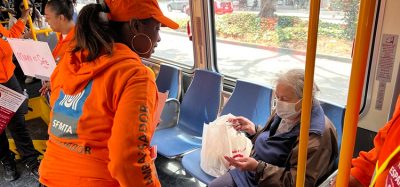The CCTV system in the entire bus fleet of Madrid
- Like
- Digg
- Del
- Tumblr
- VKontakte
- Buffer
- Love This
- Odnoklassniki
- Meneame
- Blogger
- Amazon
- Yahoo Mail
- Gmail
- AOL
- Newsvine
- HackerNews
- Evernote
- MySpace
- Mail.ru
- Viadeo
- Line
- Comments
- Yummly
- SMS
- Viber
- Telegram
- Subscribe
- Skype
- Facebook Messenger
- Kakao
- LiveJournal
- Yammer
- Edgar
- Fintel
- Mix
- Instapaper
- Copy Link
Posted: 31 October 2011 | José Ángel Rivero, General Manager, EMT Madrid | No comments yet
In May 2009, EMT Madrid started its CCTV project known as VEA (Videovigilancia Embarcada en el Autobus) for the entire bus fleet of Madrid and it was finished in July 2011. Approximately 2,000 buses running daily in the city of Madrid are now equipped with this on-board video surveillance system. The total amount of installed units is approximately 8,000: that means two to four cameras per standard vehicle and six cameras in the bendy buses.
The VEA project was launched with the objective of improving security levels on board. Although security has not been a major problem in Madrid’s buses, EMT Madrid wants to keep its buses secure – after all, it transports almost 1.7 million people per day! The VEA project is part of a more general programme called ‘eBus’ which includes hardware and software that provides EMT Madrid with full information about ticketing, mechanical failures, fleet location (GPS) and voice communication.
In May 2009, EMT Madrid started its CCTV project known as VEA (Videovigilancia Embarcada en el Autobus) for the entire bus fleet of Madrid and it was finished in July 2011. Approximately 2,000 buses running daily in the city of Madrid are now equipped with this on-board video surveillance system. The total amount of installed units is approximately 8,000: that means two to four cameras per standard vehicle and six cameras in the bendy buses. The VEA project was launched with the objective of improving security levels on board. Although security has not been a major problem in Madrid’s buses, EMT Madrid wants to keep its buses secure – after all, it transports almost 1.7 million people per day! The VEA project is part of a more general programme called ‘eBus’ which includes hardware and software that provides EMT Madrid with full information about ticketing, mechanical failures, fleet location (GPS) and voice communication.
In May 2009, EMT Madrid started its CCTV project known as VEA (Videovigilancia Embarcada en el Autobus) for the entire bus fleet of Madrid and it was finished in July 2011. Approximately 2,000 buses running daily in the city of Madrid are now equipped with this on-board video surveillance system. The total amount of installed units is approximately 8,000: that means two to four cameras per standard vehicle and six cameras in the bendy buses.
The VEA project was launched with the objective of improving security levels on board. Although security has not been a major problem in Madrid’s buses, EMT Madrid wants to keep its buses secure – after all, it transports almost 1.7 million people per day! The VEA project is part of a more general programme called ‘eBus’ which includes hardware and software that provides EMT Madrid with full information about ticketing, mechanical failures, fleet location (GPS) and voice communication. VEA CCTV has integrated the system eBus by adding another computer with cameras and 3G/Wi-Fi capabilities that communicates and integrates with the system and uses some of its features, as GPS location, driver and line details. Cameras work as the bus engine starts up and recording is constant until several seconds after the engine shuts down. The technological platform built for VEA plans has two basic resources: an Alarm Reception Centre (CRA), which centralises and manages the reception of video recordings and alarm signals and starts all procedures for action and safety protocols; and the Embedded System, which includes the hardware and software installed in the buses for capturing, recording and sending video recordings to the CRA in case of incident on board or at reverse request. The team in the CRA includes three security specialists and an EMT Madrid control agent, who is an employee with a long background at the company.
When the driver presses an alarm button, the quality of images recorded are increased and sound is also recorded at the same time. Images and sound are sent to the control centre via HSUPA (3.5G). When the bus arrives at the depot, the selected content is automatically downloaded.
CCTV cameras in Madrid are designed for several aims: actions of EMT Madrid agents especially in case of an accident; documentation of emergency situations on board; filming and storing images to produce at judge’s requests in order to clarify an incident; graphic documentation contributing to dissuade users to commit attacks or assaults against other users or against EMT Madrid’s staff. Deploying on-board staff instead of the CCTV system would be a lot more expensive. However, on night buses we have to use both: approximately 10% of the night buses also have surveillance agents on board.
The CCTV system captures images from different angles of the bus and records them, including high resolution recording and monitoring in real-time. An alarm button is accessible to the bus driver and it is directly connected to the Alarm Reception Centre (CRA). In case of an emergency situation, the CRA warns the emergency local service: local fire department, police or ambulance. The most frequent incidents on board are vandalism and pickpocketing.
During the first half of 2011, EMT recorded almost 1,400 cases (63% of them were incidents among users on board and approximately 15% were vandalistic actions). The number of cases where local police acted together with EMT staff was 413 and the number of incidents/events where recorded images were required was 394. There was 121 bus routes affected by such incidents – the whole bus network in Madrid is composed of 216 routes.
Vandalism and graffiti are other very expensive issues for EMT Madrid, although the risk of aggression on board in Madrid is low if compared to other cities in Europe.
EMT Madrid has been internally promoting the need of a CCTV system among the drivers and other staff by explaining that the presence of cameras on the bus is for their safety. Externally, the company has tried to show the users this measure improves the quality of the service.
We are sure that cameras will deter people from committing crimes and the goal is to prevent crime before prosecuting it. All cameras are visible: they are installed so that one device is in front of the other. The current legislation in force requires us to put a visible sticky label somewhere to inform our users of the presence of cameras.
Communications channel for Wi-Fi
Together with the VEA system, EMT Madrid has also included a free Wi-Fi service in the whole fleet using the communications channel of the interface GPRS/UMTS/HSPA installed in the vehicles. So, Wi-Fi on board shares the hardware with the CCTV system. Madrid is the only European city at present that provides their users with free internet connection in urban buses and it is becoming more-and-more popular among passengers. Passengers tend to use this system to check personal emails and browse social networking sites, but the company must set some understandable limitations to this free use.
About the Author
José Ángel Rivero has a PhD in Economics and Business Studies from the University Complutense Madrid and holds many other academic experiences. Previously, José Ángel Rivero was Economic and Financial Programming Manager for EMT Madrid from 2007 until 2010. Before this position, he had been Managing Director for Rey Juan Carlos Foundation and World Bank consultant.







